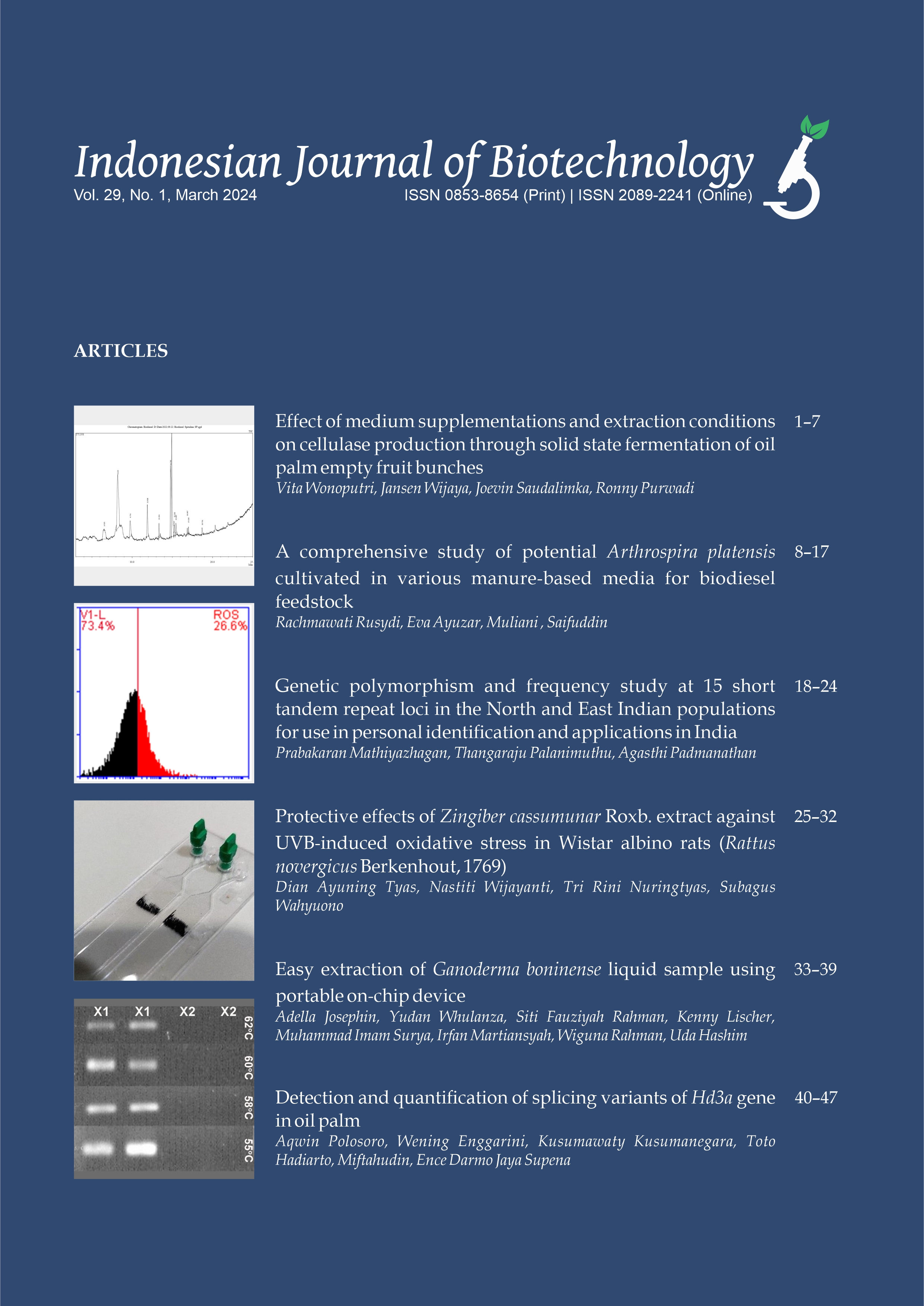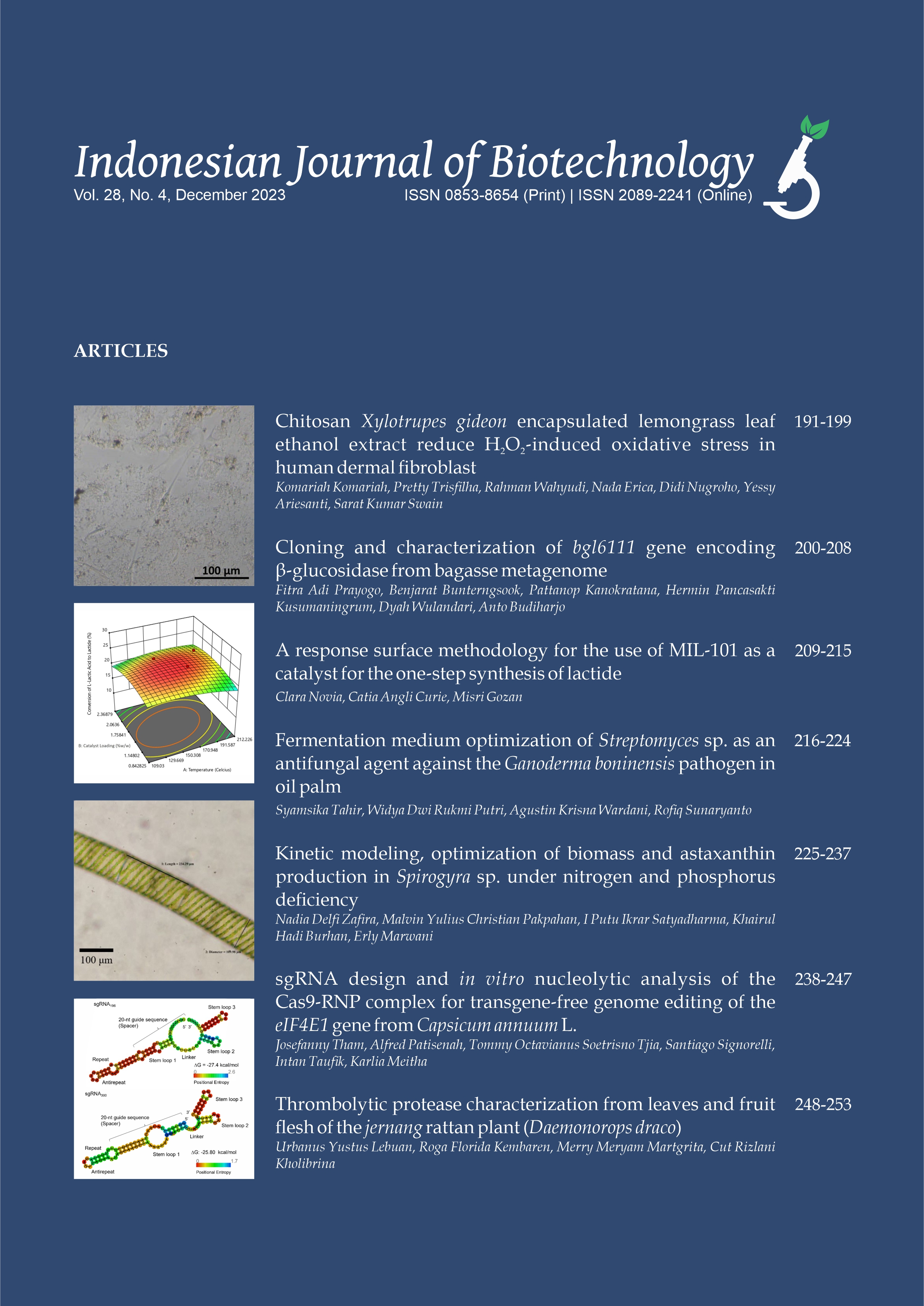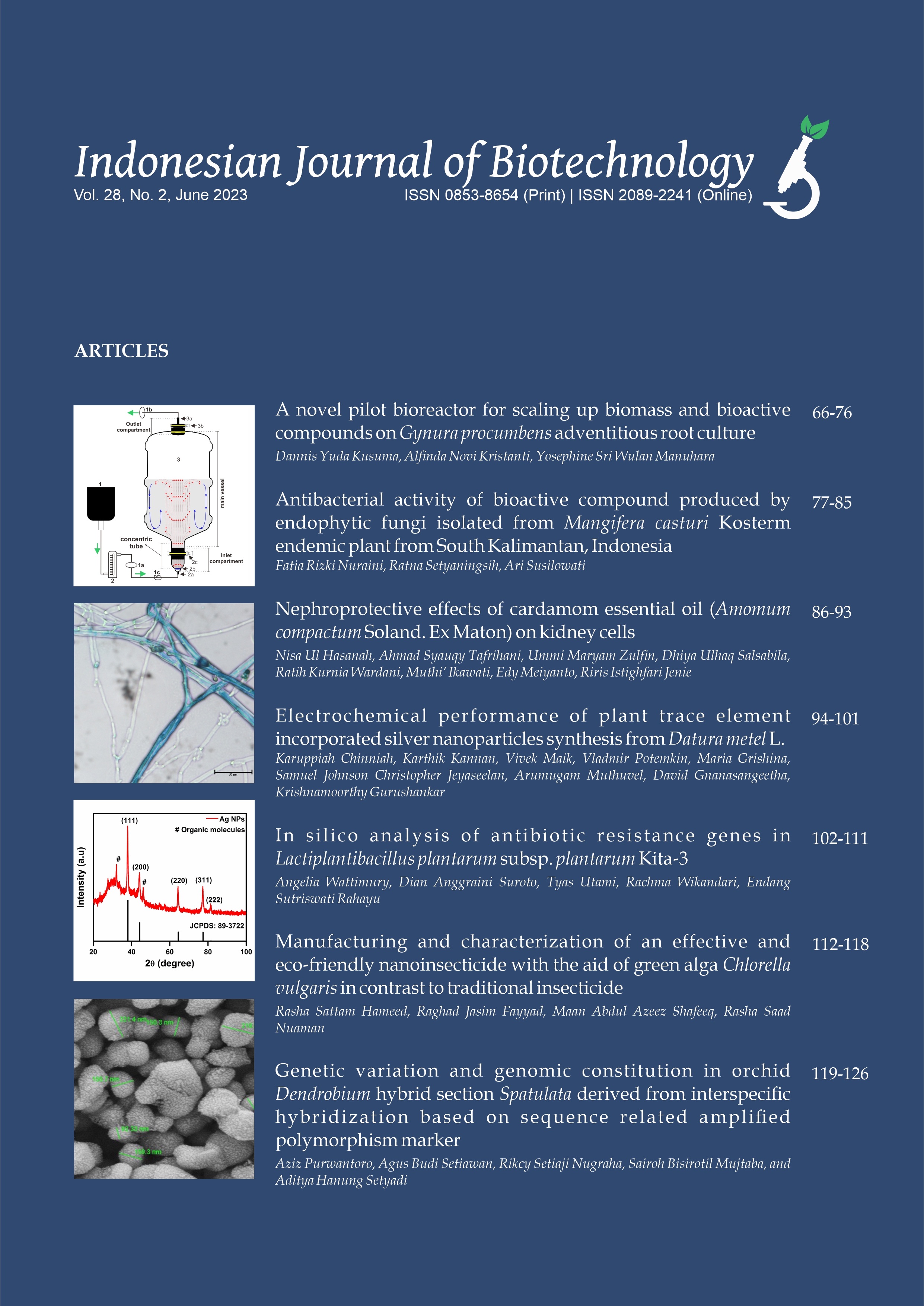Mineral Phosphate Solubilizing Bacteria Isolated from Various Plant Rhizosphere under Different Aluminum Content
Dolly Iriani Damarjaya(1*), Jaka Widada(2), Keishi Senoo(3), Masaya Nishiyama(4), Shigeto Otsuka(5)
(1) Laboratory of Soil and Environmental Microbiology, Department of Agriculture Microbiology,Faculty of Agriculture, University of Gadjah Mada, Bulaksumur, Yogyakarta 55281, Indonesia
(2) Laboratory of Soil and Environmental Microbiology, Department of Agriculture Microbiology,Faculty of Agriculture, University of Gadjah Mada, Bulaksumur, Yogyakarta 55281, Indonesia
(3) Graduate School of Agricultural and Life Sciences, The University of Tokyo. 1-1-1 Yayoi,Bunkyo-ku, Tokyo 113-8657, Japan
(4) Graduate School of Agricultural and Life Sciences, The University of Tokyo. 1-1-1 Yayoi,Bunkyo-ku, Tokyo 113-8657, Japan
(5) Graduate School of Agricultural and Life Sciences, The University of Tokyo. 1-1-1 Yayoi,Bunkyo-ku, Tokyo 113-8657, Japan
(*) Corresponding Author
Abstract
Full Text:
PDFReferences
Alexander, M., 1977. Introduction to soil microbiology. New York: John Wiley and Sons. p.467.
Altschul, S.F., Madden, T.L., Schäffer, A.A., Zhang, J., Zhang, Z., Miller, W., and Lipman, D.J., 1997. Gapped BLAST and PSI-BLAST: a new generation of protein database search programs. Nucleic Acids Res., 25, 3389-3402.
Ausubel, F.M., Brent, R., Kingston, R.E., Moore, D.D., Seidman, J.G., Smith, J.A., and Struhl, K., 1987. Current protocols in molecular biology. New Yotk: John Wiley and Sons.
Balandreau, J., Viallard, V., Cournoyer, B., Coenye, T., Laevens, S., and Vandamme, P., 2001. Burkholderia cepacia genomovar III is a common plant-associated bacterium. Appl. Environ. Microbiol., 67 (2), 982-985.
Brimecombe, M.J., De Leij, F.A.A.M., and Lynch, J.M., 2001. The effect of root exudates on rhizosphere microbial populations. In R. Pinton, Z. Varanini and P. Nannipieri (eds.) The Rhizosphere. Dekker, New York, pp. 95-140.
Curl, E.A. and Truelove, B., 1986. The rhizosphere. Advanced Series in Agricultural Sciences. Berlin, New York: Springer-Verlag, pp. 15:288.
Darrah, P.R. and Roose, T., 2001. Modeling the rhizosphere, In R. Pinton, Z. Varanini and P. Nannipieri (eds.) The Rhizosphere. Dekker, New York, pp. 327-372.
De Bruijn, F.J. 1992. Use of repetitive (Repetitive extragenic palindromic and enterobacterial repetitive intergeneric consensus sequences and the polymerase chain reaction to fingerprint the genomes of Rhizobium meliloti isolates and other soil bacteria. Appl. Environ. Microbiol. 58, 2180-2187.
De Weger, L.A., van der Bij, A.J., Dekkers, L.C., Simons, M., Wijffelman, C.A., and Lugtenberg, B.J.J., 1995. Colonization of the rhizosphere of crop plants by plant-beneficial pseudomonads. FEMS Microbiol. Ecol. 17 (4), 221-227.
Duineveld B.M. and van Veen, J.A., 1999.The number of bacteria in the rhizosphere during plant development: Relating colony- forming units to different reference units. Biol. Fertil. Soils, 28 (3), 285-291.
Estrada-De-Los-Santos, P., Bustillos- Cristales-Rocio, C.R., and Caballero- Mellado-Jesus, M.J., 2001. Burkholderia, a genus rich in plant- associated nitrogen fixers with wide environmental and geographic distribution. Appl. Environ. Microbiol., 67 (6), 2790-2798.
Haider, K., Mosier, A., and Heinmeyer, O., 1985. Phytotron experiments to evaluate the effect of growing plants on denitrification. Soil Sci. Soc. Am. J., 49, 636-641.
Haller, T. and Stolpe, H., 1985. Quantitative estimation of root exudation of maize plants. Plant Soil, 86, 207-216.
Hedlund-Brian, P., Geiselbrecht-Allison, D., Timothy, J.B., and Staley,J.T., 1999. Polyciclic aromatic hydrocarbon degradation by a new marine bacterium, Neptunomonas napthovorans sp. Appl. Environ. Microbiol., 65, 251-259.
Kennedy, A.C., 1999. Bacterial diversity in agroecosystems. Agric. Ecosys. Environ., 74, 65-76.
Kraffczyk, I., Trolldenier, G., and Beringer,H., 1984. Soluble root exudates of maize: influence of potassium supply and rhizosphere microorganisms. Soil Biol. Biochem., 16, 315-322.
Liljeroth, E., Burgers, S.L., and van Veen, J.A., 1991. Changes in bacterial populations along roots of wheat (Triticum aestivum L.) seedlings. Biol. Fertil. Soils, 10, 276-280.
Lynch, J.M., 1994. The rhizosphere-form and function. Appl. Soil Ecol., 1, 193- 198.
Neumann, G. and Römheld, V., 2001. The release of root exudates as affected by the plant’s physiological status In R. Pinton, Z. Varanini and P. Nannipieri (eds.). The Rhizosphere. Dekker, New York, pp. 41-94.
Peix, A., Mateos, P.F., Rodriguez-Barrueco, C., Martinez-Molina, E., Velazquez, E. 2001. Growth promotion of common bean (Phaseolus vulgaris L.) by a strain of Burkholderia cepacia under growth chamber conditions. Soil Biol. Biochem., 33, 1927-1935.
Picard, C., Di-Cello, F., Ventura, M., Fani, R., and Guckert, A., 2000. Frequency and biodiversity of 2,4- diacetylphloroglucinol-producing bacteria isolated from the maize rhizosphere at different stages of plant growth. Appl. Environ. Microbiol., 66 (3), 948-955.
Pikovskaya, R.I., 1948. Mobilization of phosphorus in soil in connection with vital activity by some microbial species. Mikrobiologia, 17, 362-370.
Piña, R.G. and Cervantes, C., 1996. Microbial interactions with aluminium. BioMetals, 9, 311-316.
Rodríguez, H., Gonzales, T., and Selman, G., 2000. Expression of a mineral phosphate solubilizing gene from Erwinia herbicola in two rhizobacterial strains. J. Biotechnol., 84, 155-161.
Versalovic, J., Schneider, M., De Bruijn, F.J., and Lupski, J.R., 1994. Genomic fingerprinting of bacteria using repetitive sequence-based polymerase chain reaction. Methods Mol. Cell. Biol., 5 (1), 25-40.
Article Metrics
Refbacks
- There are currently no refbacks.
Copyright (c) 2015 Indonesian Journal of Biotechnology









